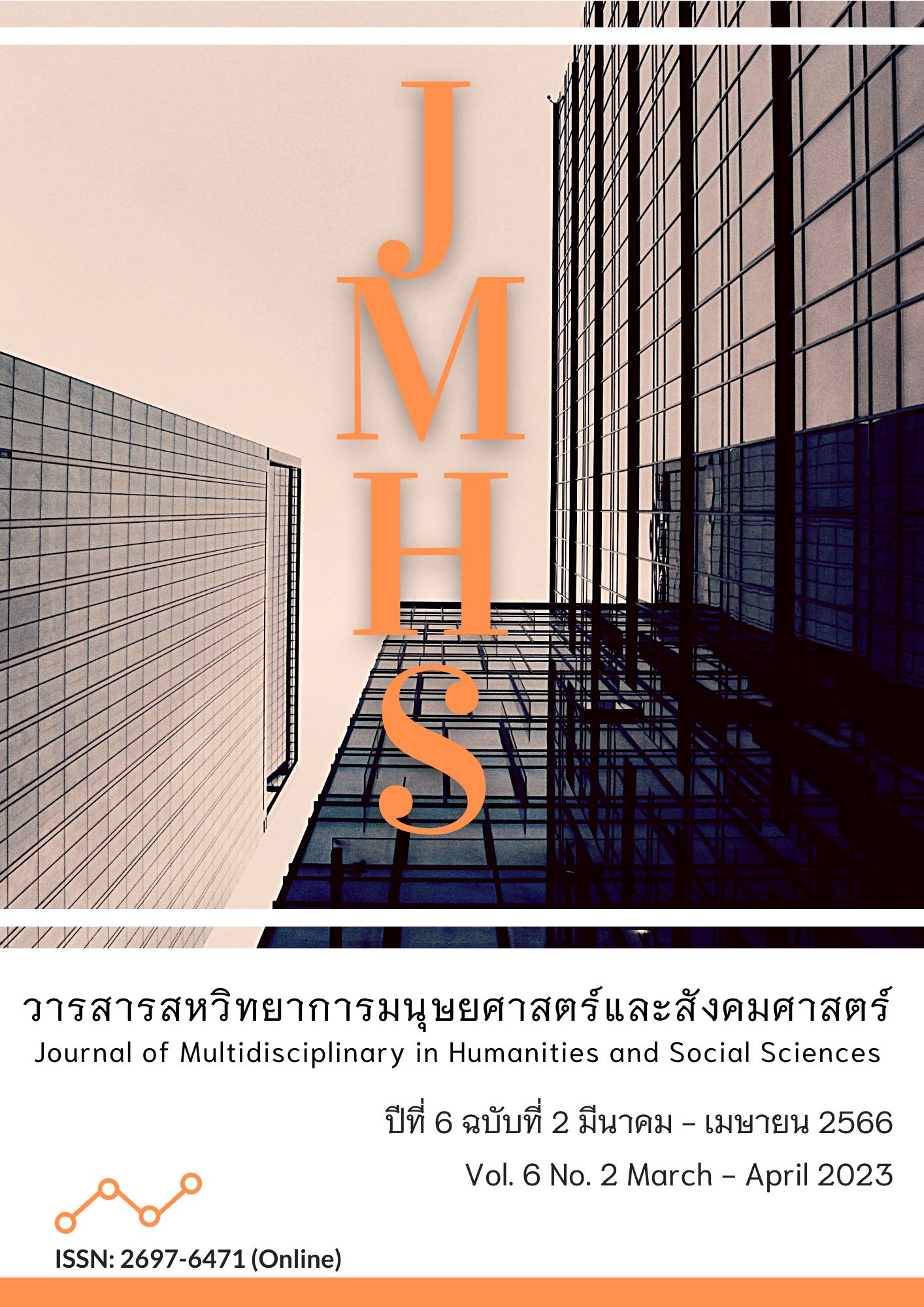A Model of The Factors Influencing Competitive Advantage of Entrepreneurs in Real Estate Industrial Business in Thailand
Main Article Content
Abstract
Article: A Model of The Factors Influencing Competitive Advantage of Entrepreneurs in Real Estate Industrial Business in Thailand. The objectives were: (1) to study the causal factors influencing the competitive advantage; (2) to develop a model of the factors affecting the competitive advantage; and (3) to study and examine the conformity of the model with empirical data of the model of factors affecting the competitive advantage of real estate industrial businesses in Thailand. This study was quantitative and qualitative research. The sample group used in the study were managers of real estate companies, juristic persons in the Bangkok area. and the eastern region, namely Chonburi, Chachoengsao, and Rayong. This was a quantitative data collection from a sample by distributing a questionnaire to 400 people using a proportional randomization method, and qualitative data were collected by interviewing 20 people using a specific sampling method. The tool used to collect data is a ready-made computer program. Data were analyzed using statistical analysis, i.e., percentage, mean, standard deviation, correlation, and route analysis.
The results of the research revealed that (1) the ability of business operations. Competitive Advantage Creation Market focus has a positive direct influence on building competitive advantage. and business performance have a positive direct influence on creating competitive advantage; (2) the development of a model of factors affecting competitive advantage of real estate business operators in Thailand. The factors of competitive advantage that play an important part are differentiation. cost leadership quick response aspect and market-oriented. (3) Consistency of the structural equation model using the LISREL 8.8 Student Version program. All indicators passed the standard. It can be concluded that the analysis results obtained from this research are consistent with the empirical data, in order of statistical significance.
Article Details

This work is licensed under a Creative Commons Attribution-NonCommercial-NoDerivatives 4.0 International License.
Views and opinions appearing in the Journal it is the responsibility of the author of the article, and does not constitute the view and responsibility of the editorial team.
References
กรมพัฒนาธุรกิจการค้า. (2561). ข้อมูลธุรกิจในพื้นที่การพัฒนาระเบียงเศรษฐกิจพิเศษภาคตะวันออก (EEC). สืบค้นเมื่อ 30 ตุลาคม 2562, จาก https://www.dbd.go.th/ download/document_file/Statisic/2562/Special/2562Q2_EEC.pdf
กัสมา กาซ้อน, ธีรศักดิ์ กัญจนพงศ์ และ นพพร ศรีวรวิไล. (2557). ผลกระทบของพฤติกรรมมุ่งตลาดและพฤติกรรมมุ่งการเรียนรู้ที่มีต่อความสามารถด้านการแข่งขันของอุตสาหกรรมยานยนต์ไทย. วารสารสุทธิปริทัศน์, 28(85), 117-144.
กิตติพงษ์ ปัญญาเรือง. (2559). กลยุทธ์ความได้เปรียบในการแข่งขันที่มีต่อผลความสำเร็จในการดำเนินงานตามแนวคิด Balance Scorecard ของวิสาหกิจขนาดกลางและขนาดย่อมแปรรูปอาหารของจังหวัดสุพรรณบุรี(วิทยานิพนธ์บริหารธุรกิจมหาบัณฑิต). มหาวิทยาลัยศิลปากร.
ณัฐ เหลืองคําชาติ และ ณัฐสพันธ์ เผ่าพันธุ์. (2563).ปัจจัยเชิงเหตุและผลของการจัดการธุรกิจอสังหาริมทรัพย์ในประเทศไทย.วารสารสังคมศาสตร์และมานุษยวิทยาเชิงพุทธ, 5(9), 332-350.
ณัฐวุฒิ แสนขันติวิโรจน์ และสุมาลี รามนัฏ. (2563). อิทธิพลความได้เปรียบทางการแข่งขันและความสามารถของผู้ประกอบการที่มีผลต่อผลการดำเนินงานของผู้ประกอบการธุรกิจรับเหมาก่อสร้างในเขตกรุงเทพมหานครและปริมณฑล. วารสารการเมือง การบริหาร และกฎหมาย คณะรัฐศาสตร์และนิติศาสตร์ มหาวิทยาลัยบูรพา, 13(2), 253-268.
ปริสุทธิ์ รัตนมหาวงศ์ และคณะ. (2564). ความสัมพันธ์ของกลยุทธ์ทางการตลาด กลยุทธ์ทางการแข่งขัน และคุณค่าตราสินค้าที่มีอิทธิพลต่อความได้เปรียบทางการแข่งขันของธุรกิจอสังหาริมทรัพย์ประเภทคอนโดมิเนียม (อาคารชุด). วารสารจันทรเกษมสาร, 27(2), 373-389.
รัฐนันท์ พงศ์วิรุทธิ์ธร และ สุรชัย อุตมอ่าง. (2554). การบริหารความได้เปรียบทางการแข่งขันเพื่อความสำเร็จ ในการดำเนินงานของธุรกิจ SMEs ในเขตภาคเหนือของประเทศไทย. วารสารวิทยาการจัดการ, 28(1), 49-63.
วสุธิดา นักเกษม และ ธีระวัฒน์ จันทึก. (2562). ความสัมพันธ์เชิงสาเหตุของปัจจัยที่ส่งผลต่อการสร้างความได้เปรียบทางการแข่งขัน ของผู้ประกอบการธุรกิจบริการในเขตกรุงเทพมหานคร. Veridian E- Journal, Silpakorn University, 12(2), 2148-2167.
สมยศ นาวีการ. (2548). การบริหารเชิงกลยุทธ์. กรุงเทพฯ: บรรณกิจ.
Chesbrough, H. (2003). The era of open innovation. MIT sloan management Review, 44(3), 35-41.
Chesbrough, H. (2004). Managing open innovation. Research-Technology Management, 47(1), 23-26.
Chesbrough, H., Vanhaverbeke, W., West, J. (Eds.). 2006. Open innovation: Researching a new paradigm. Oxford: Oxford University.
Covin, J.G., & Slevin, D.P. (1988). The influence of organization structure on the utility of an entrepreneurial top management style. Journal of Management Studies, 25(3), 217-234.
Covin, J.G., & Slevin, D.P. (1991). A conceptual model of entrepreneurship as firm behavior. Entrepreneurship Theory and Practice, 16(1), 7-25.
Gill, R.D., & Eugenis, K. (2019). Do voters prefer women judges? Deconstructing the competitive advantage in state supreme court elections. State Politics & Policy Quarterly, 19(4), 399-427.
Hair, J.F., Black, W.C., Babin, B.J., & Anderson, R.E. (2010). Multivariate data analysis. (7th ed.). Prentice-Hall.
Healy, P., Serafeim, G., Srinivasan, S., & Yu, G. (2014). Market competition, earnings management and persistence in accounting profitability around the world. Review of Accounting Studies, 19(4), 1281-1308.
Kaplan, R.S. & Norton, D.P. (1992). The balanced scorecard-measures that drive performance. Boston: Harvard Business Review.
Kumar, V., Jones, E., Venkatesan, R., & Leone, R.P. (2011). Is market orientation a source of sustainable competitive advantage or simply the cost of competing?. Journal of Marketing, 75(1), 16-30.
Lado, A.A., Boyd, N.G., & Wright, P. (1992). A competency-based model of sustainable competitive advantage: Toward a conceptual integration. Journal of Management, 18(1), 77-91.
Lee, Y.K., Kim, S.H., Seo, M.K., & Hight, S.K. (2015). Market orientation and business performance: Evidence from franchising industry. International Journal of Hospitality Management, 44, 28-37.
Lumpkin, G.T. and Dess, G.G. (1996). Clarifying the entrepreneurial orientation construct and linking it to performance. Academy of Management Review, 21(1), 135-172.
Lumpkin, G.T., & Dess, G.G. (2001). Linking to dimensions of entrepreneurial Orientation to firm performance: the moderating role of environment and industry life cycle. Journal of Business Venturing, 16(9), 429-451.
Miller, D. (1983). The correlates of entrepreneurship in three types of firms. Management Science, 29(7), 770-791.
Narver, J.C., & Slater, S.F. (1990). The effect of a market orientation on business profitability. Journal of Marketing, 54(4), 20-35.
Narver, J.C., Slater, S.F., & Tietje, B. (1998). Creating a market orientation. Journal of Market-Focused Management, 2(3), 241-255.
Papadas, K.K., Avlonitis, G.J., Carrigan, M., & Piha, L. (2019). The interplay of strategic and internal green marketing orientation on competitive advantage. Journal of Business Research, 104, 632-643.
Porter, M. E. (1985). Competitive advantage: Creating and sustaining superior performance cases. New York: The Free Press.
Siriwan, U., Ramabut, C., Thitikalaya, N., & Pongwiritthon, R. (2013). The management of small and medium enterprises to achieve competitive advantage in northern Thailand. In Conference of the International Journal of Arts & Sciences, 6(1), 147-157. Retrieved
from https://www.druthit.com/uploads/files/RHS172_2.pdf
Vakola, M., Soderquist, K.E., & Prastacos, G.P. (2007). Competency management in support of organisational change. International Journal of Manpower, 28(3/4), 260-275.
Wu, H. (2012). Constructing a strategy map for banking institutions with key performance indicators of the balanced scorecard. Evaluation and Program Planning, 35(3), 303-320.


